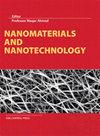Multi-response optimization of chromium/gold-based nanofilm Kretschmann-based surface plasmon resonance glucose sensor using finite-difference time-domain and Taguchi method
IF 3.3
3区 材料科学
Q2 MATERIALS SCIENCE, MULTIDISCIPLINARY
引用次数: 10
Abstract
Kretschmann-based surface plasmon resonance sensor utilizing chromium and gold nanofilms is ideal for label-free biomedical sensing. In this work, Taguchi’s L9 orthogonal array method was used to optimize the effects of three control factors and noise factor, which are the incident optical wavelength, chromium and gold nanofilm thicknesses, and their root-mean-square surface roughness, on the performance of the Kretschmann-based surface plasmon resonance sensor. The control factors were varied at three levels for a novel multi-response optimization of the Kretschmann-based surface plasmon resonance sensor for the minimum reflectivity, the full-width-at-half-maximum, and the sensitivity of 3% glucose detection, executed using Lumerical’s two-dimensional finite-difference time-domain method. Using Taguchi method, the best control factor setting in air was A3B2C2 corresponding to 785 nm optical wavelength, 0.5 nm chromium, and 50 nm gold layer thickness, respectively, with minimum reflectivity of 0.0017%, full-width-at-half-maximum of 0.4759°, and glucose-sensing sensitivity of 106.73°·RIU−1. The detection accuracy and quality factor were 0.01 and 224.26 RIU−1, respectively. It was also indicated that chromium nanofilm thickness of 0.5–3 nm and its root-mean-square surface roughness has a negligible factor effect compared to other control factors. Taguchi method’s factor effect analysis showed that for chromium layer thickness of 1–3 nm, the minimum reflectivity values are predominantly determined by the gold layer thickness with 75% factor effect, followed by optical wavelength with 11%. Factor effect of full-width-at-half-maximum is determined by optical wavelength (57%), followed by gold layer thickness (38%). Sensitivity is 88% determined by optical wavelength and 10% determined by gold layer thickness. The Kretschmann-based surface plasmon resonance glucose sensor with the best glucose-sensing sensitivity was at optical wavelength of 632.8 nm with a higher sensitivity value of 163.415°·RIU−1 but lower detection accuracy and quality factor values of 0.001 and 24.86 RIU−1, respectively, compared to near-infrared wavelength of 785 nm. In conclusion, finite-difference time-domain and Taguchi method is suitable for multi-response optimization of control and noise factors of Kretschmann-based surface plasmon resonance sensors.基于时域有限差分和田口方法的铬/金纳米膜Kretschmann表面等离子体共振葡萄糖传感器的多响应优化
基于Kretschmann的表面等离子体共振传感器利用铬和金纳米膜,是无标签生物医学传感的理想选择。在这项工作中,田口的L9正交阵列方法用于优化三个控制因素和噪声因素,即入射光波长、铬和金纳米膜厚度及其均方根表面粗糙度,对基于Kretschmann的表面等离子体共振传感器性能的影响。控制因子在三个水平上变化,用于基于Kretschmann的表面等离子体共振传感器的新的多响应优化,用于最小反射率、半最大全宽和3%葡萄糖检测的灵敏度,使用Lumerical的二维时域有限差分法执行。采用田口法,空气中的最佳控制因子设置为A3B2C2,分别对应785nm的光学波长、0.5nm的铬和50nm的金层厚度,最小反射率为0.0017%,半峰全宽为0.4759°,葡萄糖传感灵敏度为106.73°·RIU−1。检测准确度和质量因子分别为0.01和224.26 RIU−1。研究还表明,与其他控制因素相比,0.5–3 nm的铬纳米膜厚度及其均方根表面粗糙度的因素影响可以忽略不计。田口法的因子效应分析表明,对于1–3 nm的铬层厚度,最小反射率值主要由金层厚度决定,因子效应为75%,其次是光学波长11%。半最大全宽的因子效应由光学波长(57%)决定,其次是金层厚度(38%)。灵敏度88%由光学波长决定,10%由金层厚度决定。基于Kretschmann的表面等离子体共振葡萄糖传感器具有最佳的葡萄糖传感灵敏度,其光学波长为632.8 nm,灵敏度值较高,为163.415°·RIU−1,但与785 nm的近红外波长相比,检测精度和质量因子值分别较低,分别为0.001和24.86 RIU−。总之,时域有限差分和田口方法适用于基于Kretschmann的表面等离子体共振传感器的控制和噪声因子的多响应优化。
本文章由计算机程序翻译,如有差异,请以英文原文为准。
求助全文
约1分钟内获得全文
求助全文
来源期刊

Nanomaterials and Nanotechnology
NANOSCIENCE & NANOTECHNOLOGY-MATERIALS SCIENCE, MULTIDISCIPLINARY
CiteScore
7.20
自引率
21.60%
发文量
13
审稿时长
15 weeks
期刊介绍:
Nanomaterials and Nanotechnology is a JCR ranked, peer-reviewed open access journal addressed to a cross-disciplinary readership including scientists, researchers and professionals in both academia and industry with an interest in nanoscience and nanotechnology. The scope comprises (but is not limited to) the fundamental aspects and applications of nanoscience and nanotechnology
 求助内容:
求助内容: 应助结果提醒方式:
应助结果提醒方式:


